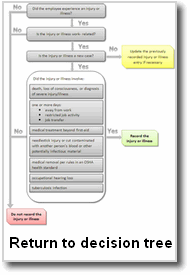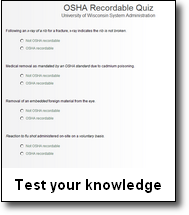Coordinators
Definition
All work-related needlestick injuries and cuts from sharp objects that are contaminated with another person’s blood or other potentially infectious material (as defined by 29 CFR 1910.1030) must be entered as an OSHA recordable injury on the OSHA tab.
Also, to protect the employee’s privacy, you must mark “yes” in the privacy box on the OSHA tab. This will prevent the employee’s name from appearing on the OSHA 300 Log.
Details
(1) What does “other potentially infectious material” mean?
The term “other potentially infectious materials” is defined in the OSHA Bloodborne Pathogens standard at Section 1910.1030(b). These materials include:
(i) Human bodily fluids, tissues and organs, and
(ii) Other materials infected with the HIV or hepatitis B (HBV) virus such as laboratory cultures or tissues from experimental animals.
(2) Does this mean that I must record all cuts, lacerations, punctures, and scratches?
No, you need to record cuts, lacerations, punctures, and scratches only if they are work-related and involve contamination with another person’s blood or other potentially infectious material. If the cut, laceration, or scratch involves a clean object, or a contaminant other than blood or other potentially infectious material, you need to record the case only if it meets one or more of the recording criteria on the decision tree.
(3) If I record an injury and the employee is later diagnosed with an infectious bloodborne disease, do I need to update the OSHA tab?
Yes, you must update the classification of the case on the OSHA tab if the case results in death, days away from work, restricted work, or job transfer. You must also update the description to identify the infectious disease and change the classification of the case from an injury to an illness.
(4) What if one of my employees is splashed or exposed to blood or other potentially infectious material without being cut or scratched? Do I need to record this incident?
You need to record such an incident on the OSHA 300 Log as an illness if:
(i) It results in the diagnosis of a bloodborne illness, such as HIV, hepatitis B, or hepatitis C; or
(ii) It meets one or more of the recording criteria in Section 1904.7.
Other references
OSHA Recordkeeping Handbook: For more information on recording criteria for cases involving needlesticks.


